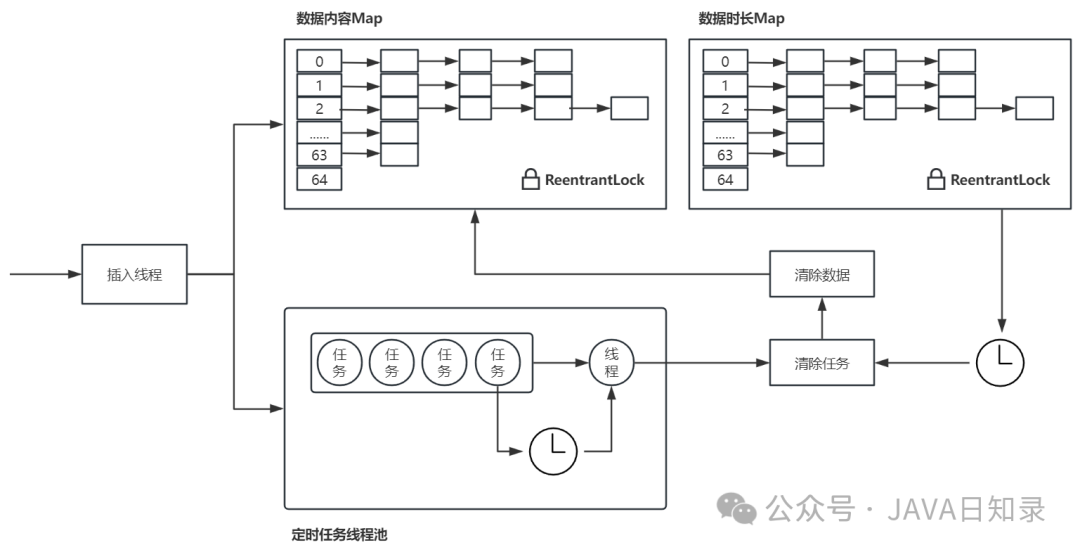在日常开发中有很多这样的场景:有一些业务系统的配置信息,数据量不大,修改频率不高,但是访问很频繁。如果每次程序都从数据库或集中式缓存中获取,受限于硬盘 I/O 性能、远程网络访问限制等,程序的执行效率不高。在这样的业务场景中,我们可以通过本地缓存来提升数据访问的效率。
今天我们来基于ConcurrentHashMap与ScheduledThreadPoolExecutor来实现一个线程安全的本地缓存:LocalCache。在 LocalCache 中支持永久缓存与临时缓存,永久缓存的数据一直有效,临时缓存的数据在指定时间到期之后会自动从缓存中移出。
LocalCache 提供了数据安全的增、删、改、查功能,具体方法如下所示:
1. 设计原理
LocalCache 主要由 3 个部分组成:数据缓存、数据超时时间、数据清理任务。数据缓存和数据超时时间都采用ConcurrentHashMap来存储数据,数据超时时间中 Key 为数据存储的键,value 是数据的时间戳。数据清理任务采用ScheduledThreadPoolExecutor实现任务调度,默认的任务线程数为 1,这样可以避免多线程带来的并发修改问题,同时线程都是内存操作,这样单线程同样具备高性能。
本地缓存的设计如下图所示:
image-20240402165304172
每次项缓存中插入数据时,LocalCache 首先会将数据插入到 ConcurrentHashMap 中。然后判断有没有设置超时时间,如果有超时时间,LocalCache 会将失效时间插入到 ConcurrentHashMap 中,并创建数据清理任务,之后任务提交到 ScheduledThreadPoolExecutor 线程池中。
每次从缓存中查询数据,LocalCache 会直接从 ConcurrentHashMap 中读取数据。
定时任务线程池会按照超时时间来触发数据清理任务,数据清理任务会从数据时长的缓存池中获取 Key 对应的时间,判断当前 Key 对应的数据是否已经到期了。如果数据已经到期了,LocalCache 会调用 remove 方法将数据从缓存池中移除。
2. 实现方案
LocalCache作为本地缓存的接口,定义了数据插入、数据删除、数据查询的相关接口方法。DefaultLocalCache 定义了两个 ConcurrentHashMap 变量:dataMap 和 timeOutMap。dataMap 用来缓存数据信息,timeOutMap 用来存储数据失效的时间戳,同时还定义了数据清理任务 ClearTask,ClearTask 负责将过期的数据从 dataMap 中移除。UML 图如下所示:
image-20240402165313203
3. 代码展示
3.1 接口定义
public interface LocalCache<V> { /** * 插入数据,数据永久有效 */ boolean put(String key, V value);
/** * 插入数据,在指定时间内生效 */ boolean put(String key, V value, int seconds);
/** * 是否包含指定的key */ boolean containKey(String key);
/** * 获取指定Key的值 */ V get(String key);
/** * 从缓存中移除key对应的数据 */ void remove(String key);
void shutdownNow();}
复制代码
在接口 LocalCache 中定义了两个数据插入的 put 接口:一个没有到期时间,另一个有到期时间。没有到期时间表示数据永久有效,有到期时间的数据会在到期后从缓存中移除。
接口实现
在接口实现 DefaultLocalCache 内部定义了三个常量:缓存的默认大小DEFAULT_CAPACITY、最大容量MAX_CAPACITY、定时线程池的大小DEFAULT_THREAD_SIZE。核心代码如下:
public class DefaultLocalCache<V> implements LocalCache<V> { // 默认容量 private static final int DEFAULT_CAPACITY = 1024; private static final int MAX_CAPACITY = 100000;
private static final int DEFAULT_THREAD_SIZE = 1;
private final int maxSize;
//数据map private volatile ConcurrentHashMap<String,V> dataMap; //过期时间 private final ConcurrentHashMap<String,Long> timeOutMap;
//定时任务 private final ScheduledExecutorService executorService;
public DefaultLocalCache() { maxSize = MAX_CAPACITY; dataMap = new ConcurrentHashMap<>(DEFAULT_CAPACITY); timeOutMap = new ConcurrentHashMap<>(DEFAULT_CAPACITY); executorService = new ScheduledThreadPoolExecutor(DEFAULT_THREAD_SIZE) ; }
public DefaultLocalCache(int size) { maxSize = size; dataMap = new ConcurrentHashMap<>(DEFAULT_CAPACITY); timeOutMap = new ConcurrentHashMap<>(DEFAULT_CAPACITY); executorService = new ScheduledThreadPoolExecutor(DEFAULT_THREAD_SIZE) ; }
@Override public boolean put(String key, V value) { //检查容量 if(checkCapacity()){ dataMap.put(key,value); return true; } return false; }
@Override public boolean put(String key, V value, int seconds) { if(checkCapacity()){ dataMap.put(key,value); if(seconds >= 0){ timeOutMap.put(key,getTimeOut(seconds)); ClearTask task = new ClearTask(key); executorService.schedule(task, seconds, TimeUnit.SECONDS); } } return false; }
......
class ClearTask implements Runnable{ private String key;
public ClearTask(String key){ this.key = key; } @Override public void run() { //判断缓存中是否有key if(timeOutMap.contains(key)){ //获取失效时间 Long expire = timeOutMap.get(key); //如果失效时间大于0,并且比当前时间小,则删除缓存 if(expire > 0){ long now = System.currentTimeMillis(); if(now >= expire){ remove(key); } } } } }}
复制代码
在 LocalCache 的默认实现 DefaultLocalCache 中,基于 ConcurrentHashMap 与 ScheduledThreadPoolExecutor 结合使用,使得 LocalCache 支持永久缓存与临时缓存两种能力。












评论